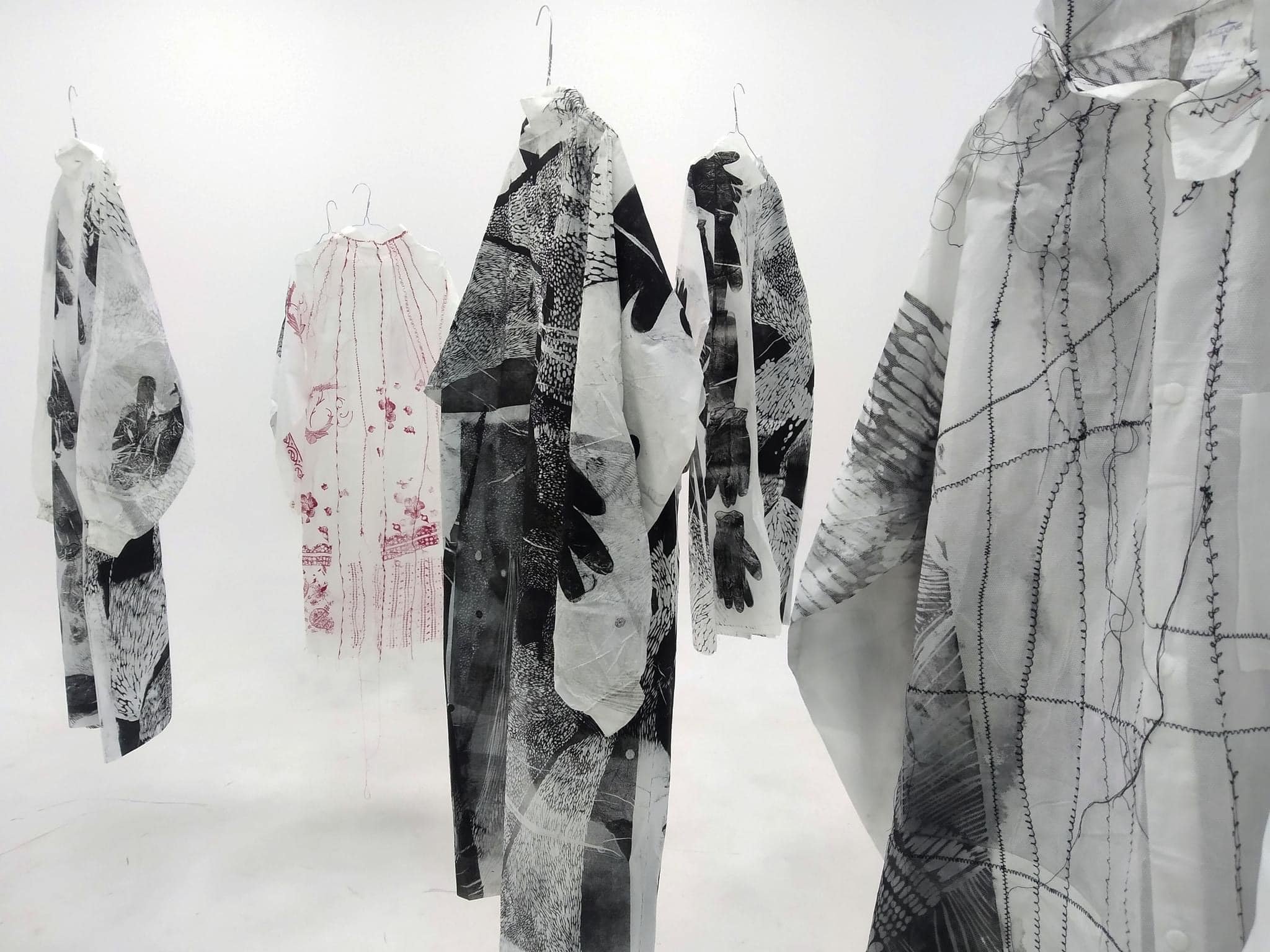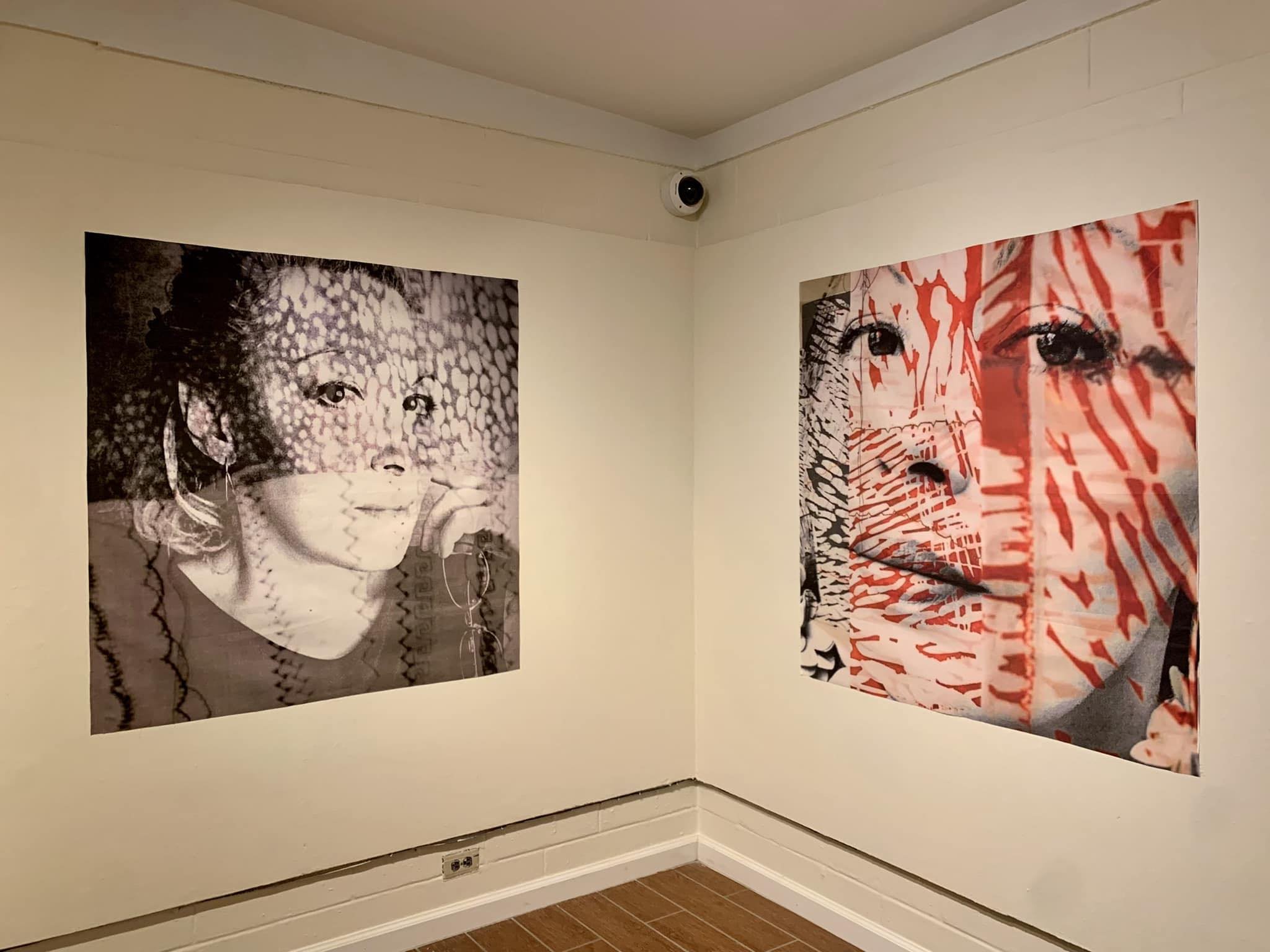026: Irena Keckes
Irena Keckes, an associate professor of art at the University of Guam, is a seasoned practitioner of printmaking, specializing in relief prints, linocuts, and woodcuts.
Robes
Irena Keckes
Dr. Keckes' art reflects her diverse cultural experiences and themes such as Buddhist philosophy, feminism, and environmentalism. She views printmaking as a labor-intensive yet rewarding practice, embodying a deeply conscious process. Drawing inspiration from artists like Thomas Kilpper and Valgerdur Hauksdottir, she embraces the multifaceted nature of printmaking, continually evolving her techniques and artistic expression over her extensive career.
Mindful Repetitions
Irena Keckes
Her artistic and academic journey began during her undergraduate studies at the Academy of Fine Arts in Croatia, where she cultivated a deep appreciation for print media. This eventually led her to continue her exploration in Japanese woodblock printmaking, through an MFA at the Tokyo University of the Arts, further refining her skills and techniques. Later, her pursuit of a Ph.D. at the University of Auckland in New Zealand finally allowed her to delve into large-scale woodcuts and print installations, shaping her unique artistic voice.
Reflecting on her years in school, Dr. Keckes acknowledges the pivotal role they played in shaping her artistic trajectory. Her passion for liberal arts and proficiency in drawing laid the groundwork for her eventual specialization in printmaking. With each artwork, she seeks to capture the essence of her experiences, drawing from her observations of the world and her inner reflections.
Woomanhood
Irena Keckes
Dr. Keckes' creative process involves meticulous research, sketching, and carving before bringing her visions to life through printing. Despite the challenges inherent in artmaking, she approaches each piece with enthusiasm and a sense of discovery. Through her work, she aims to address socially relevant themes, particularly focusing on the role and representation of women in society, striving to reach diverse audiences, and bridge cultures and communities through the universal language of creativity.
Daydream
Irena Keckes
For aspiring artists, such as those she teaches at UOG, Dr. Keckes offers advice rooted in authenticity, persistence, and a willingness to experiment. She encourages them to seek opportunities to showcase their work while remaining true to their artistic vision.
To read Dr. Keckes’ full interview, continue reading below. Also, visit her Instagram as well as her website to check out more of her work. Thank you again for your time, Professor!
Carving Process
Irena Keckes
Please introduce yourself and describe what you do.
My name is Irena Keckes, I am associate professor of art at University of Guam. I teach printmaking, drawing, basic design, environmental art, and studio for non-majors classes.
How would you define art?
I create mainly relief prints, linocuts, and woodcuts, and I often print them on cotton or linen fabrics. This is large-scale work and I often exhibit it in form of installations in a space of a gallery. My academic background, years of studies and research, helped structuring my experience in print media field, and the progress is ongoing. Attending major international printmaking conferences and exhibitions has been crucial in networking with artists from all over the world and sharing passion and love for this art form. Everything I learnt about printmaking so far, is always present in my work, and I apply it to further develop concepts and themes I explore through my art. Love for art has taken me to live and work in so many different places in world, and while creating art, I immerse in diverse cultures, which all inspired me to become a more inclusive and open-minded as an artist and person.
Why did you choose your art form?
During my undergraduate studies at Academy of Fine Arts in Zagreb, in 1990s where I learnt relief and intaglio print processes, I fell in love print media and that inspired me to go to Japan to study Japanese woodblock printmaking at Tokyo University of the Arts. Later, I further developed my print practice and explored different ideas during my Ph.D. studies at University of Auckland in New Zealand. I was in particular interested in creating large-scale woodcuts, moving more towards print installation and researching expanded field of print. I explored printmaking as a meditative practice, phenomenological ways of knowing uniting mind and body, and my own perceptions and lived experiences of world. Learning and experimenting with always new ways of making prints, never really ends. In more recent years, I mostly print on fabric, create installations in space of a gallery. I print large scale prints on cotton or linen fabric by hand, using ‘baren’ (Japanese tool for hand printing), or wooden spoon, or press machine if size of a fabric is not too large. I also incorporate element of sewing and threads sewn in my fabric pints. Sometimes, I exhibit only matrixes, carved wooden blocks. Very often, the process of making/creating itself is more important to me then outcome, and it becomes the main theme of my work that is abstract, meditative, capturing movement, channeling life energies, inner ‘landscapes, and often reflects thoughts, analyses, and observations from surrounding environments.
How did your high school/college years affect the work you make today?
I went to classical gymnasium high school in my hometown Karlovac, Croatia. That is the high school where Nikola Tesla went 154 years ago! That is also the school where I got my first job teaching art history. My favorite subjects were all liberal arts subjects such as history, art history, geography, English and French languages, music, philosophy, sociology, psychology. During the high school time, I became more interested in art, and I was very good in drawing and painting. I discovered my passion for printmaking later, during the college and my studies at Academy of Fine Arts in Zagreb.
Who do you idolize?
I don’t idolize anyone, but I have been inspired by artists that make large scale printmaking and print installations, such as: German artist Thomas Kilpper, and Icelandic artist Valgerdur Hauksdottir.
Where do you get your inspiration?
Printmaking is not an easy media to learn, there are multiplicity of methods and processes. As indirect art discipline, taking steps throughout print processes teaches us to think tactically, purposefully, creatively, critically, and to plan steadily. It teaches us in a way, to be resilient. Moreover, it involves exciting processes through which we work with both our minds and body, explore, and gain skills in both art and craft, and develop personal visual art language. Printmaking involves hands on artistic processes and frequent research in methods and ideas. It may apply traditional methods and be as innovative and experimental. It is multifaceted but also very labor intensive; it requires concentration, commitment, and enthusiasm; it is challenging, exciting, creative, and rewarding art form. Printmakers often work in shared studios; thus collaboration, partnership, and cooperation are important aspects of our work.
What do you do when you're stuck on an artwork or lacking motivation or inspiration?
I haven’t experienced yet this situation.
What do you like incorporating most into your art?
My artworks are abstract, meditative, and it involves unity of body-mind-heart. Printmaking is very labor-intensive practice. I print both by hand using Japanese hand printmaking tool ‘baren’ or a wooden spoon, and I also use printmaking press to create my art. Themes of my art include meditative practices, Buddhist philosophy, environmental art, non-toxic printmaking processes, feminism, and I also often collaborate with other printmakers from around the world. I am part of two international printmaking collective, and we often exhibit together in major international printmaking conferences and exhibitions.
What is something that you add to your art as your signature?
Printing on fabric; incorporating sewing thread in my prints; print installations, collaborative work; experimental printmaking; expanded field of print.
Take us through your process for making art.
I first draw make research on the theme I am interested in and then I make sketches / drawings as part of the research; and then the carving process starts. Once the blocks-matrices are carved, I print. The entire processes are a research through making.
What do you struggle with the most when making art?
I wouldn’t say artmaking is a struggle. To me making art is like ‘dancing in the rhythm of the Universe’. I am open to experimenting and always trying something new, even if printmaking is a labor-intensive practice. I am passionate about it, and I find a great pleasure and meaning through this work.
What role do artists have in society?
Creativity is important in any career, as well as critical thinking that is both developing through art practices. Artists have a role in society, as art we make reflects on and is relevant for times, we live in. Very often artists themes are socially relevant themes. For example, my more recent prints were exploring womanhood and a position of women in societies.
What characteristics do you think all artists share?
Passion for art making and seeing art that other artists make.
What’s your favorite place in Guam?
Southern part of the Island.
How has your artwork evolved over time?
I hope I answered that under the previous questions. Over time I explored different themes, and I printed on various materials. Over past 30+ years that I have been actively making art, and learning about diverse printmaking processes, my art expression has been evolving and changing. This is still ongoing!
Why did you choose to become an artist?
Long time ago, when I was a teenager, I discovered that art is what I was good at, and I enjoyed most! Art has always been my forte. I knew I will be able to succeed in art as this was what I was most passionate about and driven to learn more and make more art. I have also been passionate about teaching, so the path of studying art with dream to become an art teacher and artist has been my goal since I was very young, and it is still now.
Is your art geared towards a specific audience?
My art is geared towards ALL audiences. As a printmaker, however, I show more internationally in printmaking biennials, triennials, conferences, and more, so I would say that majority of my audiences are professionals who are also printmakers. However, my art is for all communities and audiences, without limits.
Do you have any tips for aspiring artists?
Be true to yourself, be persistent and consistent in making art, look for opportunities to show art in group and individual shows locally, nationally, and internationally. Be open to new things and experimenting with art, visit other artists exhibitions, network, and never stop learning.






